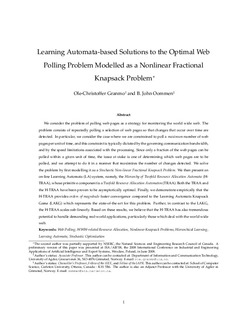| dc.contributor.author | Granmo, Ole-Christoffer | |
| dc.contributor.author | Oommen, B. John | |
| dc.date.accessioned | 2012-01-19T11:56:08Z | |
| dc.date.available | 2012-01-19T11:56:08Z | |
| dc.date.issued | 2011 | |
| dc.identifier.citation | Granmo, O. C., & Oommen, B. J. (2011). Learning automata-based solutions to the optimal web polling problem modelled as a nonlinear fractional knapsack problem. Engineering Applications of Artificial Intelligence, 24(7), 1238-1251. doi: 10.1016/j.engappai.2011.05.018 | no_NO |
| dc.identifier.issn | 0952-1976 | |
| dc.identifier.uri | http://hdl.handle.net/11250/137895 | |
| dc.description | Accepted version of an article from the journal: Engineering Applications of Artificial Intelligence. Definitive published version on Elsevier Science Direct: http://dx.doi.org/10.1016/j.engappai.2011.05.018 | no_NO |
| dc.description.abstract | We consider the problem of polling web pages as a strategy for monitoring the world wide web. The problem consists of repeatedly polling a selection of web pages so that changes that occur over time are detected. In particular, we consider the case where we are constrained to poll a maximum number of web pages per unit of time, and this constraint is typically dictated by the governing communication bandwidth, and by the speed limitations associated with the processing. Since only a fraction of the web pages can be polled within a given unit of time, the issue at stake is one of determining which web pages are to be polled, and we attempt to do it in a manner that maximizes the number of changes detected. We solve the problem by first modelling it as a stochastic nonlinear fractional knapsack problem. We then present an online learning automata (LA) system, namely, the hierarchy of twofold resource allocation automata (H-TRAA), whose primitive component is a twofold resource allocation automaton (TRAA). Both the TRAA and the H-TRAA have been proven to be asymptotically optimal. Finally, we demonstrate empirically that the H-TRAA provides orders of magnitude faster convergence compared to the learning automata knapsack game (LAKG) which represents the state-of-the-art for this problem. Further, in contrast to the LAKG, the H-TRAA scales sub-linearly. Based on these results, we believe that the H-TRAA has also tremendous potential to handle demanding real-world applications, particularly those which deal with the world wide web | no_NO |
| dc.language.iso | eng | no_NO |
| dc.publisher | Elsevier | no_NO |
| dc.title | Learning automata-based solutions to the optimal web polling problem modelled as a nonlinear fractional knapsack problem | no_NO |
| dc.type | Journal article | no_NO |
| dc.type | Peer reviewed | no_NO |
| dc.subject.nsi | VDP::Mathematics and natural science: 400::Information and communication science: 420::Knowledge based systems: 425 | no_NO |
| dc.subject.nsi | VDP::Technology: 500::Information and communication technology: 550 | no_NO |
| dc.source.pagenumber | 1238-1251 | no_NO |
| dc.source.volume | 24 | no_NO |
| dc.source.journal | Engineering Applications of Artificial Intelligence | no_NO |
| dc.source.issue | 7 | no_NO |
